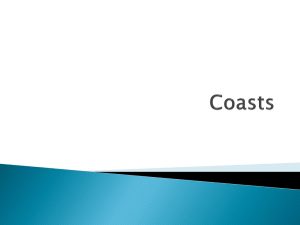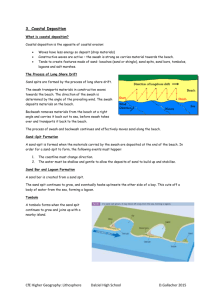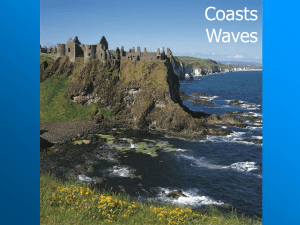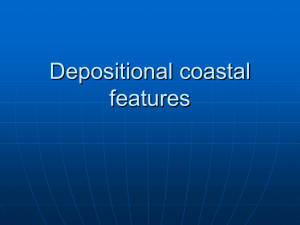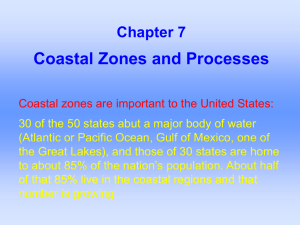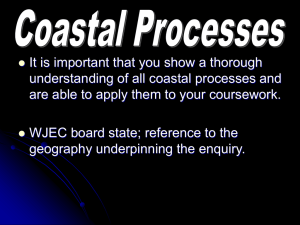9. The Sea - Moyle Park College
advertisement
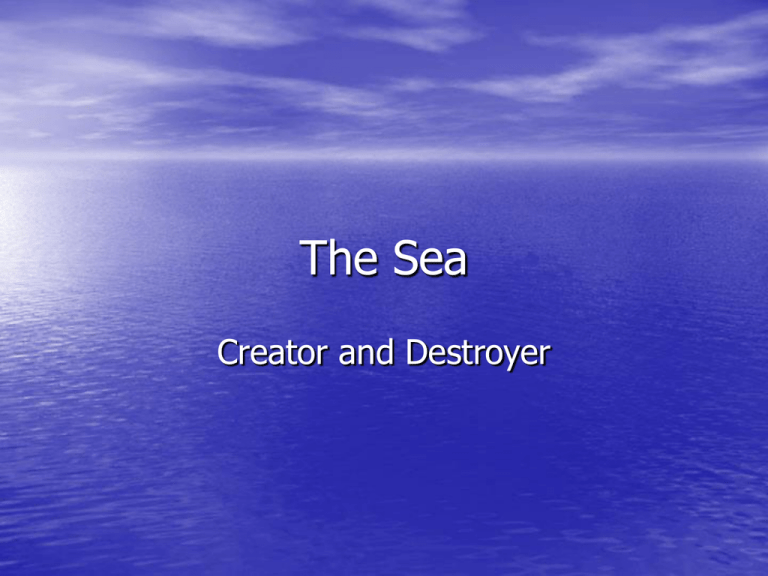
The Sea Creator and Destroyer The action of the sea • The sea is constantly changing the shape of our coastline. • This is happening because waves, like rivers, erode, transport, and deposit material. • Waves move material along our coastline. Why do waves break on the Shoreline? Waves • Waves are made because of friction between the wind and the surface of the sea. • The size of the wave depends on 2 things. 1. The strength of the wind. 2. The length of the sea (fetch). Waves – Swash & Backwash • Swash – As the wave reaches the shore it breaks. The white foamy water that flows up the beach is called the Swash. • Backwash – When the water runs out of speed it stops and it flows back down the beach into the sea. This is called the backwash. Constructive waves • They have a strong Swash which transports and deposits material on the beach. • They have a weak Backwash which does not carry much material back to the sea. • As a result they construct/add material to the beach. Constructive Waves Destructive waves • They have a weak Swash. • They have a very strong Backwash which wears away and carries away material form the beach. • Therefore, there is a lot of erosion and they destroy/destruct the coastline. Destructive Waves Sea Erosion • Sea erosion is caused by Destructive waves. They erode the coast in 4 ways. 1. 2. 3. 4. Hydraulic Action Air Compression Abrasion Attrition Sea Erosion 1. Hydraulic Action – this is the power of the water hitting the coastline. 2. Air Compression – The waves trap air in crack in the rocks. As the waves retreat the trapped air expand quickly and can crack the rock. Sea Erosion 3. Abrasion – this is erosion caused by small rocks carried in the sea water hitting against the coastline. 4. Attrition – this is erosion caused by the small stones hitting each other breaking themselves into smaller pieces. Landforms of Sea Erosion • Like rivers, the sea creates many features or landforms as a result of erosion. These include, 1. 2. 3. 4. Cliffs Bays and Headlands Sea caves, sea arch, sea stack, sea stump Blowhole Cliffs • As the waves break onto the coast they cut a • • • notch into the rock. When the notch gets deeper the overhanging rock collapses. This process continues and the coastline retreats inland. The material that falls into the sea form the cliff is called a wave cut platform. E.g. Cliffs of Moher, Co. Clare. Bays and Headlands • A bay is wide deep opening into the coastline. • A headland is a piece of land jutting out into the sea. • Bays and headlands form when there are different types of rocks occur along the coastline. • The softer rocks are eroded quickly creating a bay. • The harder rocks are eroded slowly and so they stick out into the sea • E.g. Dublin Bay & Howth Head Bays and Headlands Caves, Arches, Stacks & Blowholes Sea Cave • A sea cave is a tunnel or passage at the base of a cliff. • The waves erode a weak point (soft rock or an area with cracks/joints) in the cliffs. This forms a passage called a cave. Sea Arch • A sea arch is a passage that runs completely through the headland. • This can happen when a cave is eroded deep into headland, or if two caves on either side of the headland are eroded and join up to form a complete passage. Sea Stack and sea stumps • A sea stack is a pillar of rock standing in the water near the coast. • When sea arches are eroded further they become wider. • Their roof collapses leaving a piece of land isolated from the coast. • This is a sea stack. It will be further eroded by the sea to form a sea stump. Blowhole • A blowhole is a passage from a cave up to the • • • • surface of a cliff top. Compress air is trapped in the cave by strong waves. The pressure created cracks and loosens rock in the roof of the cave. This rock collapses over time forming a passageway called a blowhole. Sea spray spurts out of the opening during stormy weather. E.g. The Two Pistols, Co. Donegal. Caves, Arches, Stacks & Blowholes Transport by the Sea • We have already learned that rivers transport material (sand, silt, clay). This is called the rivers load. • The sea also has a load which it transports along. The load is made up of sand, pebbles, stones, and mud. Transport by the Sea • Waves are responsible for transporting the load. They do this in two ways. • 1. Up and down the shore by the Swash and the Backwash. • 2. Along the shore by a process known as Longshore Drift. Swash and Backwash • We have already looked at the processes of swash and backwash. • The swash will transport material up onto the beach. • The backwash will transport material back down the beach towards the sea. Longshore Drift • Longshore drift moves material along the beach. • This occurs when waves approach the beach at • • an angle. The swash brings material up onto the beach, then the backwash brings it back down to the sea in a straight line. The swash, again moving in at an angle will move the material further across the beach. This process continues and the load is moved along in a zig zag pattern. Deposition by the Sea • The sea deposits (drops off) some of its load in sheltered places where the waves have less energy. • This may occur in a bay, or very gently sloping shoreline. • Like river deposition which we have already studied, sea deposition also creates features or landforms. Landforms of Sea Deposition • Sea deposition creates the following features along our coastlines. 1. 2. 3. 4. 5. Beaches Sand Dunes Sand spits Tombolo Lagoons Beaches Beach • A beach is made of sand and shingle (small stones) which • • • • are deposited by the waves. The swash carries material up onto the beach. Some of this material, especially the heavier material, stays on the beach because the weak backwash cannot carry it back to the sea. The backwash carries only lighter sand particles back down towards the beach. For this reason we say that beach material is sorted, with the heavier materials furthest from the water, and the lighter sand close to the water. During storms, when the swash is very powerful, it can force heavy stones high up onto the beach where they remain to form a storm beach. E.g. sandy beach, Curracloe, Co. Wexford. Sand Dunes • Sand dunes are hills of sand which form above the high tide level. • Wind dries sand on the beach making it lighter. The sand is then blown inland until it is trapped by a wall or vegetation. • The sand builds up to form hills of sand which are sand dunes. • E.g. Portmarnock, Co. Dublin. Spits, Bars, Tombolo, Lagoon Sand Spit • A sand spit is a ridge of sand or shingle which • • • extends out into the sea. It is connected to the land at one end. Longshore drift moves material along the beach. When it reaches a shallow bay the waves have less energy and they deposit some of the load on the sea bed. This material builds up over time and rise above the sea water. E.g. Tramore, Co. Waterford. Tombolo • A tombolo is a ridge of sand or shingle which connects an island to the coastline. • A tombolo is formed when a sand spit occurs linking an island to the coastline rather than stretching across a bay. • E.g. At Howth, Co. Dublin. Lagoon • A lagoon is a body of water cut off from the sea • • • by a sand spit. When a sand spit is formed it stretches out across a bay. It may eventually reach the other side of the bay closing off the water behind it. This water forms a saltwater lake called a lagoon. E.g. Lough Gill, Co. Kerry. Spits, Bars, Tombolo, Lagoon People and Coastlines • The sea plays an important part in our lives. Many people live by the coast, and most of the worlds largest cities are in coastal regions. • The sea provides us with energy (oil, gas, wave power) as well as leisure activities, transport routes, and food. People and Coastlines • However, the sea can also be destructive. People have tried to control this destructive power of the sea using, • 1. Sea Walls • 2. Boulders • 3. Groynes People and Coastlines • Sea Walls – Sea walls are concrete walls with a curved top on them which helps to deflect the waves back out to sea. • Boulders – Large rocks are placed at the base of cliffs or in front of sand dunes. It prevents erosion by reducing the power of the waves. • Groynes – Groynes are low walls built of wood. They are built at right angles to the shore to help prevent sand being moved along the beach by Longshore Drift. Protecting the Coastline using Groynes Protecting the Coastline using Boulders Tourism and our Coastline
